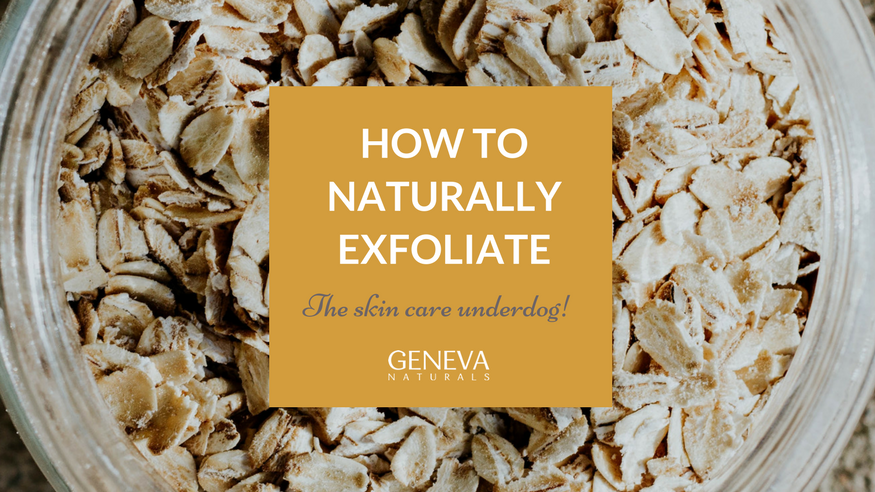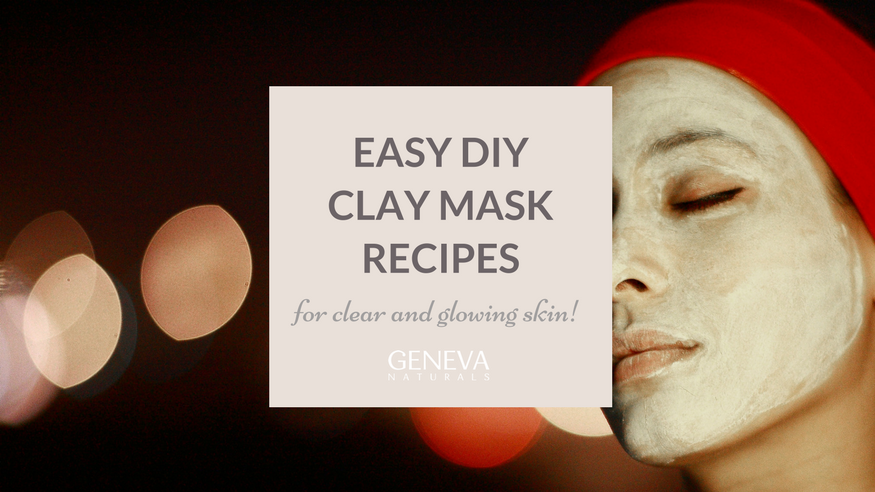DIY Exfoliating - The Skin Care Underdog


Most of us are pretty good at cleansing and moisturizing our skin daily, but what about exfoliation? This often-skipped step is key to maintaining beautiful skin. The outer layer of our skin sheds around a million microscopic dead skin cells a day (crazy, right?), a necessary cycle to make way for new, healthy ones. And even though most of those cells are shed naturally, enough of them remain behind and quickly accumulate on the skin’s surface to clog pores, trap bacteria and result in an uneven, dull complexion, blemishes, and exaggerated wrinkles and fine lines. This is where exfoliating comes in: gently removing these excess dead skin cells just once or twice a week can make a world of difference to your skin!
Why Is Exfoliation Important?
Regular exfoliation has numerous benefits for your skin. Here are just a few:
Shrinks your Pores
The formula is simple: dirty pores=large pores; clean pores=smaller pores. Excess dirt and grime not only literally enlarge pores, but they also create the illusion of larger pores and make them more prominent. Exfoliating your skin rids pores of those extra particles, allowing them to shrink and become much less noticeable.
Brightens your Complexion
Rather than try to cover up an uneven or dull skin tone with makeup, exfoliate it to brighten it up naturally. Sloughing off dead cells that are left behind allows for quicker turnover and reveals a smoother, more even skin tone without having to cake on layers of foundation.
Fights Wrinkles
Exfoliating fights aging in two ways: it lowers the outermost surface of dead skin to minimize the appearance of existing fines lines and wrinkles, and promotes good skin health to prevent new ones from forming.
Improves Effectiveness of Skin Care Products
If you’re frustrated that your dutiful regimen isn’t doing for your skin what it’s supposed to, adding exfoliating to your routine may help. Because it deeply cleans, opens up pores, and gets rid of excess dead skin on the face, exfoliating creates the perfect palate for the application of your other products. Instead of just sitting on the surface, those products can penetrate and more deeply absorb into fresh, clean, exfoliated skin.

How to Naturally Exfoliate
These days, it’s all about keeping it natural, and for good reason! Although there is no shortage of choices when it comes to purchasing exfoliators, you'll often pay a pretty penny for them. If you want to experience the benefits of exfoliating but aren’t ready to shell out big bucks for it, there are other ways to naturally and effectively exfoliate your skin. Here are some natural exfoliators that will freshen and revitalize your skin using common ingredients and products found in your own home.
Baking Soda
It doesn’t get much cheaper or basic than baking soda, but this common alkaline compound is a fantastic at-home exfoliator. It’s especially effective on the neck and face because it has a naturally brightening effect and can help to naturally lighten skin that has been darkened by age spots or sun exposure. It’s just abrasive enough to give your delicate facial skin a deep cleanse and clear off unwanted skin cells without damaging it.
Directions: Combine baking soda with your everyday liquid cleansing soap to form a paste (add water if needed). For especially dry skin types, you can add a small amount of coconut oil for additional moisture. Scrub your face with gentle, circular motions, avoiding your eyes; rinse with warm water and pat dry.
Coffee
If you can’t get through the morning without your cup of Joe, save those coffee grounds—and some cash—to use as a natural exfoliator!
Directions: add 2 tablespoons of coffee grounds to ½ cup sugar and ¼ cup oil to create an invigorating scrub for your face and body. Not only will the combination of the grounds and the sugar help to rid your skin of unwanted debris and cells, but as a bonus, coffee has been shown to reduce the appearance of cellulite and stretch marks, and has antioxidants to keep your skin looking more youthful and vibrant.
Sugar Scrubs
A natural source of glycolic acid, sugar is an excellent exfoliator as it breaks down and gently removes dry, flaky skin. It’s slightly abrasive but not overly so, so it’s ideal for most skin types and safe to use all over your body. Sweetening up your beauty routine with a sugar scrub—white or brown both work great—will leave your skin feeling especially smooth and refreshed.
Directions: combine equal parts brown or white sugar and either coconut, almond, or olive oil and work into a smooth paste. You can add a few drops of your favorite essential oils for added benefits and scent. Stored in an airtight container, your homemade sugar scrub will keep for 1-2 months for you to use once or twice a week for smooth, nourished skin from head to toe. For a visual tutorial, check out this video from Carina Stewart:
Love sugar scrubs? Check out more DIY sugar scrub recipes for your body, not just your face. The rest of your body is less sensitive, so you can use stronger ingredients without worrying about damaging your skin.
Oatmeal
This pantry staple is a breakfast favorite for many, but did you know it’s also an effective exfoliant? Perfect for extra-sensitive skin, oats are gentle and nourishing without being overly abrasive or irritating. They are super absorbent (think about how they draw in moisture while being cooked) and are able to more easily and quickly remove excess dirt, oils, and dead skin cells. Using oatmeal on your face will leave it feeling gently but thoroughly nourished, hydrated, and clean.
Directions: combine 1 tablespoon of dry oatmeal with about 3 tablespoons of warm water, and allow it to sit for up to 10 minutes to soften before applying to your skin. Gently massage for 1-2 minutes before removing with warm water and patting dry. For a boost of vitamin A and calcium to help with acne and overall skin health, you can mix the oatmeal with warm milk instead of water.
Dry Brushing
Short on time but still want to exfoliate your skin? No problem! You don’t have to always use a cream or scrub to do the job; you can easily give your skin a quick and basic exfoliation with a good quality soft-bristle brush or even a dry towel.
Directions: After showering or bathing, dry off as normal and use your brush or a fresh dry towel to gently slough off any extra skin cells. Though it’s not as thorough as using a specific exfoliating product or recipe, and you don’t get any bonuses like vitamins or minerals, dry brushing takes only minutes and your skin will benefit from this quick once-over, feeling softer and smoother overall. Be sure to follow with a good moisturizer if your skin feels dry.
Salt

Another popular at-home exfoliator, regular table salt is slightly less abrasive than sugar and is great for smoothing the skin anywhere on the body. Not only does it exfoliate, but it also cleanses and detoxifies, fights bacteria and dries up blemishes and impurities. Coarse sea salt is a great option to help soften up particularly rough areas, like hands, elbows, knees and feet. Salt scrubs can cost upwards of $20-30 but for a fraction of that cost you can make your own at home.
Directions: mix two parts salt (coarse or fine depending on your intended use) with one part oil of your choice, such as olive, coconut, grapeseed, or almond oil, and add 5-10 drops of your favorite essential oil. Combine into a workable paste and store in an airtight container. Use it once a week in the shower or bath to create silky smooth complexion.
Lemons
When life gives you lemons…make an exfoliator! They may be small, but lemons pack a powerful punch and have lots of benefits for your skin. Like baking soda, they are a natural skin brightener; like salt, they help to pull harmful toxins from the skin’s surface, and they’re packed with vitamin C to help increase elasticity, boost collagen production, and prevent fine lines and wrinkles. As an exfoliator, lemon juice contains alpha hydroxyl acid, which removes the protein ‘glue’ that helps dead skin cells cling to the skin’s surface, making it easier to slough them off.
Directions: combine the juice of one lemon with 1 tablespoon good quality olive oil, 5 tablespoons of white sugar, and 1 teaspoon honey. Rub onto damp skin in a gentle circular motion, rinse well with warm water, and follow with your favorite moisturizer.
Exfoliated Skin is Happy Skin
You’ve only got one body; treat it right by making sure to exfoliate regularly. We can’t stop the process of aging, but we can minimize its signs on our skin. It doesn’t take a weekly trip to the dermatologist or a ton of money to achieve a soft, beautiful complexion. Save yourself some time and money by adding an all-natural exfoliator to your beauty routine, and pretty soon your epidermis will go from showing…to glowing!
To find affordable luxury skin care products, or even more DIY recipes for your complexion, check out our anti-aging line:
Also in Geneva Naturals

What Is A Retinoid Oil? Retinoid Oil Benefits, Uses, Effects & More

DIY Clay Mask Recipes for Clear Skin



